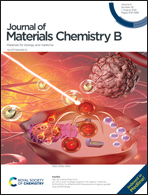The shrinking behavior, mechanism and anti-shrinkage resolution of an electrospun PLGA membrane
Abstract
The deformation shrinkage of a poly(lactide-co-glycolide) (PLGA) fibrous material seriously affects its biomedical application. To demonstrate the underlying shrinking mechanism and to find a method to prevent the shrinkage of an electrospun PLGA membrane, we investigated the shrinking behavior of PLGA electrospun membranes under various test conditions and discussed the underlying shrinking mechanism. The results indicated that the shrinkage of the electrospun PLGA membrane was mainly regulated by the glass transition of its polymer fiber; the temperature and liquid environment were found to be the two main factors leading to the shrinkage of the electrospun PLGA membrane through affecting its glass transition. Then a heat stretching (HS) technique was proposed by us to stabilize the electrospun PLGA membrane. After HS treatment, the glass transition temperature (Tg) of the electrospun PLGA membrane could increase from 48.38 °C to 54.55 °C. Our results indicated that the HS-treated membranes could maintain a high area percentage of 90.89 ± 2.27% and 84.78 ± 3.36% after immersion respectively in PBS and blood at 37 °C for 2 hours. Further experiments confirmed that the HS technique could also stabilize the dimensional structure of the electrospun PDLLA membrane in PBS and blood at 37 °C. This study provides an effective strategy for preventing the shrinkage of electrospun polyester biomaterials in a physiological environment that may benefit both the material structural stability and the in vivo biological performance.



 Please wait while we load your content...
Please wait while we load your content...